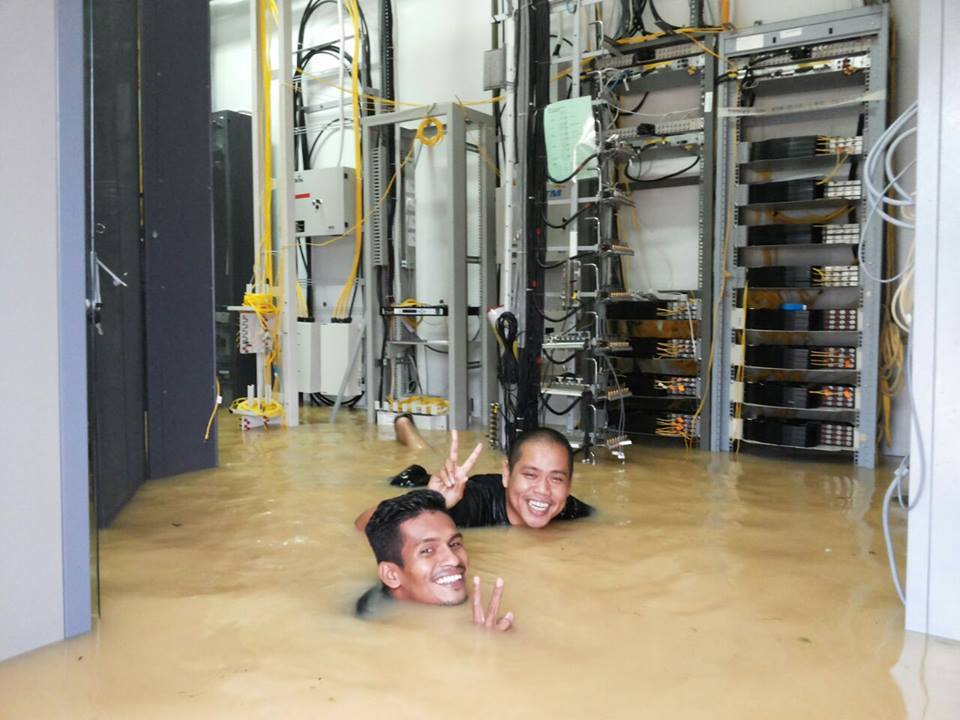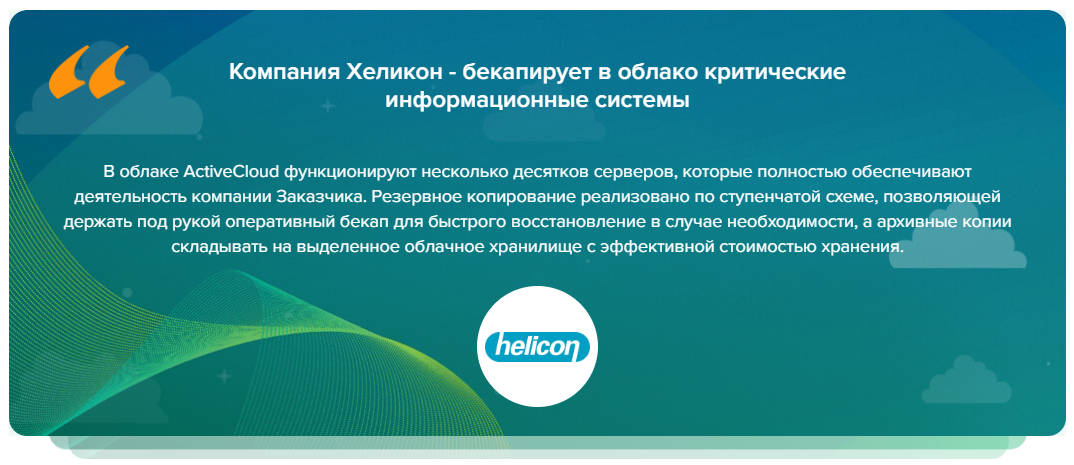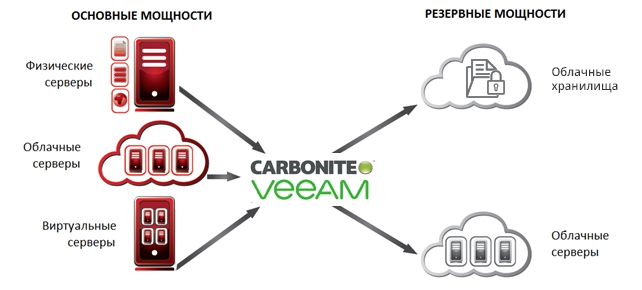We reserve IT systems for reasonable money
I think no one will argue that having a reliable backup and backup infrastructure is always good. The number of natural and man-made disasters in the world is growing every year, and the damage from them is measured in hundreds of billions of dollars. Let the chance to suffer from a major incident is not so great, but with local troubles in the spirit of a power outage, flooding or fire in the server room, we often face it.
Anything happens - sometimes offended employees take revenge on business, law enforcement agencies sometimes take equipment, sometimes foreign IP addresses accidentally fall under the Roskomnadzor block, and once a truck went into the local server room of our customer — right through the wall from the street.

Do all companies need a hot spare to quickly switch to the second platform? Not really. Real-time backup is important if business-critical business processes for continuous customer service depend heavily on software running on central servers. In this case, both image losses are frightening, and the cost of downtime is easy enough to calculate, therefore, money for the RLCD is usually found. Moreover, such IT systems are often initially designed in a disaster-resistant version.
If the unavailability of IT systems only leads to wasted employees' working time and hypothetically could lead to fines for late submission or poorly served by a secret buyer, then the cost of a hot reserve business approves reluctantly.
The difficulty is that if you come to a system integrator with the task of redundancy, then in accordance with the accumulated experience you will most likely be offered a time-tested approach to analyzing business risks, developing DRP and a hardware based solution with hardware synchronization functionality. In addition to the high cost, such solutions have another drawback - they are difficult to implement without a significant modernization of the main site, which, as a rule, no one wants to touch.
Nevertheless, for truly critical business systems, these are reasonable risks and costs, because there is no other way, but what if the systems are not sufficiently critical for an “adult” and beautiful project?
You can, of course, reconcile and not do anything, and if something does happen, shrug and get a hat from the business. You can contract an integrator to calculate a backup data center, make a pilot, estimate a budget, present a solution to a business, get “no money yet” in response and postpone the project until better times. This, of course, will not save the company from idle time, but it is difficult to present the IT department with claims in case of force majeure, because “well, we offered you,” and new knowledge of the DR-solutions market will not be superfluous. Such options also have the right to life, but the business may not survive the loss of data, and then you have to look for a new job.

You can not invest in a full backup data center, but make your life easier for the future by setting up a secondary (or even primary) backup of data in the cloud. Today, BaaS services (backup as a service) are offered by many service providers, and on the basis of the most diverse software. If you use some popular backup solution inside you, then you can certainly find a similar service with convenient native integration with your current software. Or, alternatively, you can rent inexpensive S3-compatible storage from the provider and put backups there — the work on the S3 protocol today is supported by the decisions of many vendors. The advantages of this approach are obvious - for reasonable money you get insurance against the risk of being left without physical access to the data and the opportunity to recover in the same cloud if necessary.
How quickly you can upgrade your systems from backup depends on the previously spent testing efforts, the availability of a prepaid resource pool for recovery and a DR-procedure written together with the service provider. However, even if you only have a bare backup, you still run your business systems in the cloud, though not very quickly, and the support of the BaaS provider will help you with this.

But what if the damage from the downtime of IT systems is obvious to everyone, but not so great as to spend money on a full-fledged DR project with business risk analysis and equipment and a second site?
Here again service providers come to the rescue, offering cloud infrastructure already distributed over several geographical sites. You just need to move your servers to the cloud, and the service provider will take care of the rest.
If you don’t want to go to the cloud entirely for some reason (for example, if you spent your own hardware and server hardware not so long ago), then the option with software synchronization in a cloud of several especially valuable servers will do. You can rent computing resources and storage, available synchronization software from a cloud provider and donate a deployed DR solution for support. This is a fairly convenient option, and you do not have to pay for a survey of your IT systems, the preparation of a technical project and other stages of a full-fledged project - you can limit yourself to an inexpensive typical setting.
The use of cloud services eliminates the need to predict the number of required licenses for DR-software and annually pay for the renewal of vendor support to maintain access to updates. In case of difficulties, you can promptly receive technical support in Russian from the provider’s support (instead of psychological in English, as is often the case with vendors). After all, the hoster knows its service, since he set it up and maintains it himself, and the software manufacturer will have to painfully understand the logs and correspondence, and what is configured inside of you.

In general, renting a service from the cloud has a significant plus compared with purchasing equipment for a project, even if we do not compare the cost of ownership. These are low costs if something went wrong. If it does not take off at all, then we simply refuse the hosting services and that's all, but you will not refuse your hardware.
Similar stories are actually familiar to many IT executives. A couple of years ago, we performed a cloud-ready survey at an engineering company, and one of the prerequisites for moving to the cloud was the slow operation of business systems. All application data lay on the entry-level storage, and its performance was simply not enough. However, during the audit, we found an excellent mid-range cost from the eminent vendor, acting as a file exchanger. In response to our dumb "why?" Question, the customer told a story about data loss due to a rare bug and unwillingness to take risks again, although the vendor had fixed the bug long ago.
Actually, in the practice of ActiveCloud there were quite a few situations when the purchased hardware could not be used for the initial goals, or it was introduced into the battle with a delay of several months. Should I take these risks on myself, when it is possible to transfer them to the provider, the question is interesting.
ActiveCloud offers its customers both backup services to the cloud storage based on Veeam software, and a hot backup service to the cloud based on Carbonite software (ex-Double-Take). Services allow periodically backing up or real-time synchronization with the iron cloud and virtual servers on all popular hypervisors. Services are offered on a rental model and include everything you need: cloud resources, necessary software, 24x7 support, and a quick start setup.

If you have a similar task and desire to discuss it - write to dmitriy.yashin@activecloud.ru .
Anything happens - sometimes offended employees take revenge on business, law enforcement agencies sometimes take equipment, sometimes foreign IP addresses accidentally fall under the Roskomnadzor block, and once a truck went into the local server room of our customer — right through the wall from the street.

Do all companies need a hot spare to quickly switch to the second platform? Not really. Real-time backup is important if business-critical business processes for continuous customer service depend heavily on software running on central servers. In this case, both image losses are frightening, and the cost of downtime is easy enough to calculate, therefore, money for the RLCD is usually found. Moreover, such IT systems are often initially designed in a disaster-resistant version.
If the unavailability of IT systems only leads to wasted employees' working time and hypothetically could lead to fines for late submission or poorly served by a secret buyer, then the cost of a hot reserve business approves reluctantly.
The difficulty is that if you come to a system integrator with the task of redundancy, then in accordance with the accumulated experience you will most likely be offered a time-tested approach to analyzing business risks, developing DRP and a hardware based solution with hardware synchronization functionality. In addition to the high cost, such solutions have another drawback - they are difficult to implement without a significant modernization of the main site, which, as a rule, no one wants to touch.
Nevertheless, for truly critical business systems, these are reasonable risks and costs, because there is no other way, but what if the systems are not sufficiently critical for an “adult” and beautiful project?
You can, of course, reconcile and not do anything, and if something does happen, shrug and get a hat from the business. You can contract an integrator to calculate a backup data center, make a pilot, estimate a budget, present a solution to a business, get “no money yet” in response and postpone the project until better times. This, of course, will not save the company from idle time, but it is difficult to present the IT department with claims in case of force majeure, because “well, we offered you,” and new knowledge of the DR-solutions market will not be superfluous. Such options also have the right to life, but the business may not survive the loss of data, and then you have to look for a new job.

You can not invest in a full backup data center, but make your life easier for the future by setting up a secondary (or even primary) backup of data in the cloud. Today, BaaS services (backup as a service) are offered by many service providers, and on the basis of the most diverse software. If you use some popular backup solution inside you, then you can certainly find a similar service with convenient native integration with your current software. Or, alternatively, you can rent inexpensive S3-compatible storage from the provider and put backups there — the work on the S3 protocol today is supported by the decisions of many vendors. The advantages of this approach are obvious - for reasonable money you get insurance against the risk of being left without physical access to the data and the opportunity to recover in the same cloud if necessary.
How quickly you can upgrade your systems from backup depends on the previously spent testing efforts, the availability of a prepaid resource pool for recovery and a DR-procedure written together with the service provider. However, even if you only have a bare backup, you still run your business systems in the cloud, though not very quickly, and the support of the BaaS provider will help you with this.

But what if the damage from the downtime of IT systems is obvious to everyone, but not so great as to spend money on a full-fledged DR project with business risk analysis and equipment and a second site?
Here again service providers come to the rescue, offering cloud infrastructure already distributed over several geographical sites. You just need to move your servers to the cloud, and the service provider will take care of the rest.
If you don’t want to go to the cloud entirely for some reason (for example, if you spent your own hardware and server hardware not so long ago), then the option with software synchronization in a cloud of several especially valuable servers will do. You can rent computing resources and storage, available synchronization software from a cloud provider and donate a deployed DR solution for support. This is a fairly convenient option, and you do not have to pay for a survey of your IT systems, the preparation of a technical project and other stages of a full-fledged project - you can limit yourself to an inexpensive typical setting.
The use of cloud services eliminates the need to predict the number of required licenses for DR-software and annually pay for the renewal of vendor support to maintain access to updates. In case of difficulties, you can promptly receive technical support in Russian from the provider’s support (instead of psychological in English, as is often the case with vendors). After all, the hoster knows its service, since he set it up and maintains it himself, and the software manufacturer will have to painfully understand the logs and correspondence, and what is configured inside of you.

In general, renting a service from the cloud has a significant plus compared with purchasing equipment for a project, even if we do not compare the cost of ownership. These are low costs if something went wrong. If it does not take off at all, then we simply refuse the hosting services and that's all, but you will not refuse your hardware.
Similar stories are actually familiar to many IT executives. A couple of years ago, we performed a cloud-ready survey at an engineering company, and one of the prerequisites for moving to the cloud was the slow operation of business systems. All application data lay on the entry-level storage, and its performance was simply not enough. However, during the audit, we found an excellent mid-range cost from the eminent vendor, acting as a file exchanger. In response to our dumb "why?" Question, the customer told a story about data loss due to a rare bug and unwillingness to take risks again, although the vendor had fixed the bug long ago.
Actually, in the practice of ActiveCloud there were quite a few situations when the purchased hardware could not be used for the initial goals, or it was introduced into the battle with a delay of several months. Should I take these risks on myself, when it is possible to transfer them to the provider, the question is interesting.
ActiveCloud offers its customers both backup services to the cloud storage based on Veeam software, and a hot backup service to the cloud based on Carbonite software (ex-Double-Take). Services allow periodically backing up or real-time synchronization with the iron cloud and virtual servers on all popular hypervisors. Services are offered on a rental model and include everything you need: cloud resources, necessary software, 24x7 support, and a quick start setup.

If you have a similar task and desire to discuss it - write to dmitriy.yashin@activecloud.ru .
